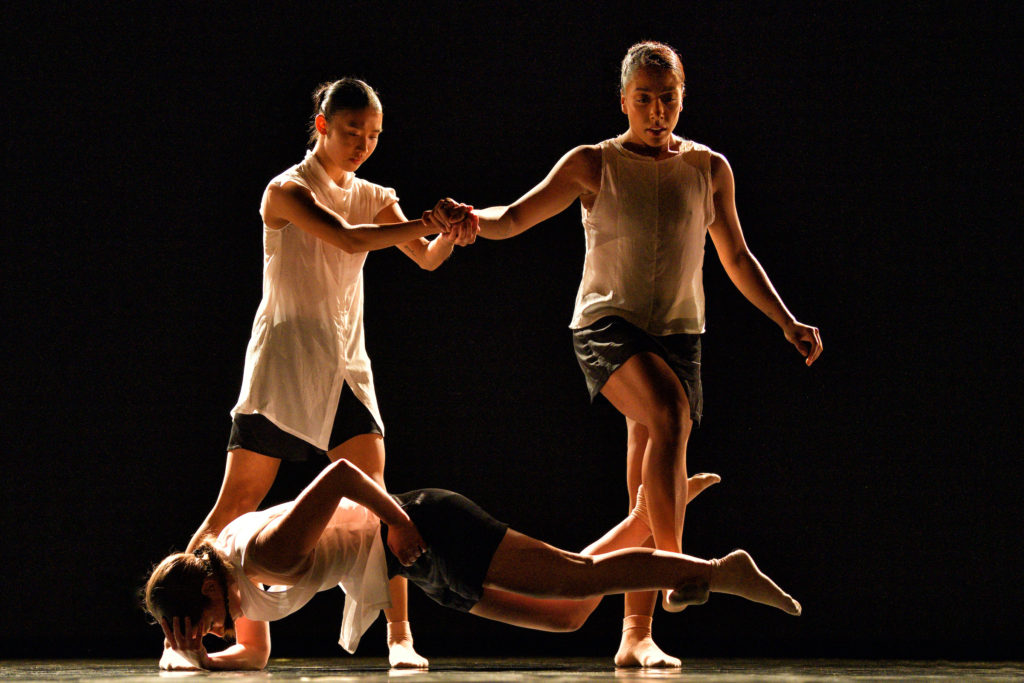Vancouver’s fall season, and Ballet BC, have liftoff - Vancouver Ballet Society
- Home
- City Reports 2020 - 2023
- Vancouver’s fall season, and Ballet BC, have liftoff

By Kaija Pepper
Vancouver’s in-theatre fall dance season has begun! The much-missed DanceHouse series took off in late October with a performance at the Playhouse by Victor Quijada’s RUBBERBAND group from Montreal. In Ever So Slightly, featuring 10 super-charged young dancers, Quijada’s mix of street and contemporary dance styles made for a bright, well-paced 75 minutes. With a seductive score created and played live by Jasper Gahunia and William Lamoureux, the evening felt celebratory, despite a house capacity capped at 50 percent. While theatres are now allowed full houses (patrons must be double vaxxed and wear a mask), many organizations are being cautious.
On November 4, Ballet BC opened next door at the Queen Elizabeth Theatre, with the same 50 percent capacity. This was the company’s first live program under artistic director Medhi Walerski, and the first time in 606 days that Ballet BC was on its home stage.

The roster of 13 dancers (plus six “emerging artists”) has undergone another transformation, with former apprentices now full members and several stalwarts departed. It was a joy to see Emily Chessa (in her ninth season) and Livona Ellis (tenth season) bring dramatic weight to gestural poses and often playful steps in the premiere of Lesley Telford’s Lean-to. Kate Burrows’ costumes — sheer white tunics that left the five dancers’ legs and arms bare — helped show off the choreography on the evening’s trademark dark stage. With music provided live by a quintet from Pacific Baroque Orchestra, Lean-to had a warm formal presence that enlivened the cavernous Queen-E Theatre.
Telford was joined on the mixed bill by fellow Vancouverites Josh Martin and Lisa Gelley Martin, whose After We Glow was a subtle, sombre premiere danced by Evan Rapaport and Justin Rapaport. After We Glow seemed to tease out a relationship between the two brothers: they are constantly in unison until, suddenly, they are not. A sculpture of fluorescent tubes, by lighting designer James Proudfoot, glowed orange, then white and pink. I was grateful when the duo were close enough so that light fell more directly on their faces and bodies; the shiny material of their costumes (by Burrows) helped catch the stage’s minimal illumination.

Stadium, by emerging choreographer Ethan Colangelo from Toronto, opened the evening with deep lunges and long reaches, set to an industrial score by Travis Lake. The program’s closer, Walerski’s Garden, was created for Nederlands Dans Theater in 2016. With all ten dancers costumed in beige or golden bodysuits (depending on the lighting) that revealed their lithe contemporary lines, and set to a dramatic piano quintet by Saint-Saëns, Garden provided an uplifting dose of impressive pure dance to send us home on.
Garden will be remounted as part of Ballet BC’s triple bill for Montreal’s Danse Danse series, at Place des Arts December 1-4. The shows almost didn’t happen. Road closures due to British Columbia’s unprecedented weather, with atmospheric rivers leading to disastrous flooding and mudslides — whole sections of highway are missing on several routes — meant the containers with their sets had no way to leave the province. But happily at least one route opened up, and the sets crossed the country to make the first stop on November 25, in Ottawa, for the two-city tour east.
Also happily, Red Sky Performance, with no major set pieces, were able to fly in the necessary equipment for shows November 24-27 at Simon Fraser University’s downtown theatre. The Toronto group, which has been on tour since September 12, were a second DanceHouse offering, in conjunction with SFU Woodward’s Cultural Programs. Trace — choreography by Jera Wolfe; direction and concept by Sandra Laronde, Red Sky’s founding artistic director — was another celebratory evening, marking the theatre’s first show since the pandemic, with capacity capped at 75 percent.

The concept of the 55-minute Trace is a broad one to do with the creation stories of Indigenous people, specifically Anishinaabe (reflecting Laronde’s heritage). It widens out to look at “what we leave behind as humans, as a culture, as a nation, and as an individual.” These ideas provide context for the choreography, which has power and purpose in every scene.
Wolfe, of Métis heritage and a graduate of the Royal Winnipeg Ballet’s school, has been creating work, mostly in hometown Toronto, for the last few years. The six dancers in Trace (four are graduates of Ryerson University’s dance program) are gymnasts and warriors as well as dance artists, shifting dynamics with impressive grace. In thrilling pas de deux, bodies intertwine like streams of water or other forces of nature. Eliot Britton’s electronic and instrumental score, with three onstage musician/vocalists, was equally intoxicating.
Special moments of stage magic happened through upstage video projections, such as those showing celestial bodies or a 1921 Department of Indian Affairs circular about “dissuading the Indian from excessive indulgence in dancing.” When the circular’s projected words start to disintegrate, white letters falling like snowflakes, it feels like a hopeful thing. Or so it seemed to me, in an evening in which choreographic depth and detail communicated something optimistic and exciting.
Finally, dance played its usual part in the Chutzpah! Festival at the Rothstein Theatre. There were, understandably, no international dance artists this year, although the festival’s new artistic managing director, Jessica Mann Gutteridge, did bring Project inTandem from outside the province. The Calgary group of seven appeared in two well-staged pieces: Moving through, it all amounts to something by Silvie Moquin and Deep END by Meghann Michalsky. The dancers gave committed performances as introspective dreamers in the first piece and as five furies in the second.

